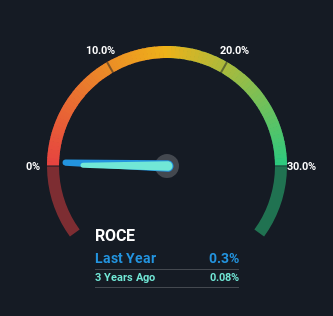If you're looking for a multi-bagger, there's a few things to keep an eye out for. Amongst other things, we'll want to see two things; firstly, a growing return on capital employed (ROCE) and secondly, an expansion in the company's amount of capital employed. This shows us that it's a compounding machine, able to continually reinvest its earnings back into the business and generate higher returns. With that in mind, we've noticed some promising trends at Pescanova (BME:PVA) so let's look a bit deeper.
What Is Return On Capital Employed (ROCE)?
If you haven't worked with ROCE before, it measures the 'return' (pre-tax profit) a company generates from capital employed in its business. To calculate this metric for Pescanova, this is the formula:
Return on Capital Employed = Earnings Before Interest and Tax (EBIT) ÷ (Total Assets - Current Liabilities)
0.0031 = €113k ÷ (€44m - €8.0m) (Based on the trailing twelve months to May 2023).
So, Pescanova has an ROCE of 0.3%. Ultimately, that's a low return and it under-performs the Food industry average of 9.4%.
View our latest analysis for Pescanova

Historical performance is a great place to start when researching a stock so above you can see the gauge for Pescanova's ROCE against it's prior returns. If you'd like to look at how Pescanova has performed in the past in other metrics, you can view this free graph of Pescanova's past earnings, revenue and cash flow.
The Trend Of ROCE
It's great to see that Pescanova has started to generate some pre-tax earnings from prior investments. Historically the company was generating losses but as we can see from the latest figures referenced above, they're now earning 0.3% on their capital employed. In regards to capital employed, Pescanova is using 28% less capital than it was five years ago, which on the surface, can indicate that the business has become more efficient at generating these returns. This could potentially mean that the company is selling some of its assets.
For the record though, there was a noticeable increase in the company's current liabilities over the period, so we would attribute some of the ROCE growth to that. The current liabilities has increased to 18% of total assets, so the business is now more funded by the likes of its suppliers or short-term creditors. It's worth keeping an eye on this because as the percentage of current liabilities to total assets increases, some aspects of risk also increase.
The Bottom Line
In summary, it's great to see that Pescanova has been able to turn things around and earn higher returns on lower amounts of capital. And since the stock has fallen 32% over the last five years, there might be an opportunity here. That being the case, research into the company's current valuation metrics and future prospects seems fitting.
One more thing: We've identified 6 warning signs with Pescanova (at least 4 which don't sit too well with us) , and understanding these would certainly be useful.
While Pescanova isn't earning the highest return, check out this free list of companies that are earning high returns on equity with solid balance sheets.
New: Manage All Your Stock Portfolios in One Place
We've created the ultimate portfolio companion for stock investors, and it's free.
• Connect an unlimited number of Portfolios and see your total in one currency
• Be alerted to new Warning Signs or Risks via email or mobile
• Track the Fair Value of your stocks
Have feedback on this article? Concerned about the content? Get in touch with us directly. Alternatively, email editorial-team (at) simplywallst.com.
This article by Simply Wall St is general in nature. We provide commentary based on historical data and analyst forecasts only using an unbiased methodology and our articles are not intended to be financial advice. It does not constitute a recommendation to buy or sell any stock, and does not take account of your objectives, or your financial situation. We aim to bring you long-term focused analysis driven by fundamental data. Note that our analysis may not factor in the latest price-sensitive company announcements or qualitative material. Simply Wall St has no position in any stocks mentioned.
About BME:PVA
Pescanova
Through its subsidiaries, engages in the production, transformation, distribution, and commercialization of seafood.
Low risk with imperfect balance sheet.
Similar Companies
Market Insights
Community Narratives



